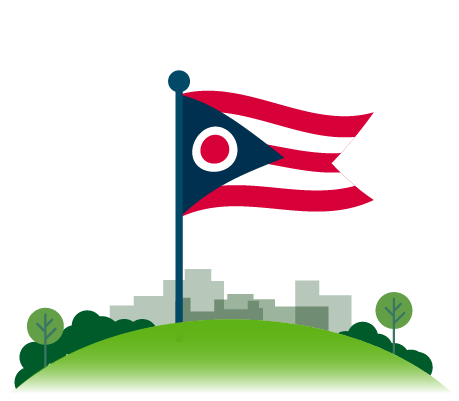
Arizona Case Study
Arizona has a long history of supporting transfer articulation policies across the state.
-
College Acceleration
Arizona promotes three forms of college acceleration programs: dual enrollment, concurrent enrollment and AP. The offerings and cost, however, vary widely across the state.
For example, dual enrollment courses are based on each district or charter school setting up its own agreement with the community college and each community college determines its own tuition and fees. For AP, Cambridge International A & AS Levels (AICE), and IB Arizona’s policies are more standardized and the state provides partial test fee waivers for low-income learners and incentive funding for teachers and schools for qualifying scores.
To support tribal colleges, Arizona reimburses tribal colleges for dual enrollment credit hours taken by high school learners.
Opportunities
-
Require all high schools to offer a minimum number of advanced-level, college acceleration courses.
-
Provide supplemental funding so all advanced-level offerings can be accessed and completed at no cost to the learner.
-
Award postsecondary credit to earned industry-valued credentials aligned with offered programs at the college.
-
-
Outcomes-Based Funding
Since 2012, Arizona has promoted a targeted performance-based funding formula. The Higher Education Budget Reconciliation Bill required Arizona’s public higher education systems to adopt a performance-based funding model specific to STEM-related credentials and other high-value degrees that are in short supply or essential to the state’s long-term economic development strategy. The model uses various performance metrics, including increases in degrees awarded, completed learner credit hours and externally generated research related to STEM.
Opportunities
-
Broaden outcomes-based funding model to incorporate other offered programs, particularly at the community college level.
-
Expand metrics to measure equitable access across learner groups and locales, as well as job placement and wage earnings.
-
Publicize progress made by institutions based on metrics annually.
-
-
State Longitudinal Data System
Arizona’s longitudinal data system, Education Learning and Accountability System (AELAS), was created for the purpose of collecting and analyzing learner data at the individual, course, institution and system levels. AELAS collects and reports learner level data from Pre-K through postsecondary.
The Data Governance Commission was established to provide oversight of the data system and is designed to take a proactive approach to using data to drive decision making at the policy and program levels.
Opportunities
-
Clarify and affirm the active participation of other state agencies in data transfer to better inform education to workforce policy and program decision making.
-
Expand AELAS to include workforce outcomes such as employment and wages.
-
Leverage and utilize information from the system to create shared state agency priorities.
-

Arkansas Case Study
The Mockingbird State is forging its own path to strengthen education to workforce pathways.
-
Targeted CTE Program Funding
In the 2019 legislative session, Arkansas passed Act 179, that provides tiered funding for high school career centers starting in 2020-21. Under the new model, these centers will receive higher funding for more expensive programs and programs that meet the “workforce needs” for the state. The Career Education and Workforce Development Board was charged with developing the tiered funding amounts, and this work will occur through the Office of Skills Development. This funding is extremely important as career centers are not eligible for federal Perkins Funds.
For districts, the Division of Career and Technical Education annually offers state start-up grants to start a new CTE program of study. Startup funds can be used within programs of study or work-based learning opportunities and must connect to a state priority and labor market data. The amount of funding however is not enough for large changes, for 2022-23 grant award amounts, for the most part, remain below $50,000.
Opportunities
-
Conduct a study to determine the adequacy of CTE funding and the potential need to increase state provided CTE funding for both schools and high school career centers.
-
Continue to provide funds to start up and improve CTE programs and their alignment to high-skill, higher-wage, high-demand occupations.
-
-
Last Dollar / Last Mile Financial Aid
Arkansas has three last dollar scholarships:
- The Arkansas Future grant provides last-dollar tuition and fees for students enrolled in STEM or regional high-demand areas of study for qualifying certificate and associate degree programs at public postsecondary institutions.
- The Arkansas Workforce Challenge scholarship provides funding for workforce training in high demand areas including healthcare, information technology and industry. The workforce challenge amount cannot exceed $800 and is lottery funded.
- The Arkansas Academic Challenge Scholarship is available for students currently in school or looking to enroll in either a two- or four-year college who have earned at least a 19 on the ACT.
Opportunities
-
Continue to analyze learner persistence outcomes by learner group to help drive decision making.
-
Consider additional funding for items such as books and travel, not traditionally covered by the grant.
-
Stackable Degrees and Credentials
Arkansas technical schools have defined stackable credentials. Students can earn certificates that can then stack to associate degrees. To further support its stackable credentials, in 2021 Arkansas Tech approved micro credentials with the goal of providing students faster access to educational attainment for short-term career advancement with a stackable credential that can lead directly to a bachelor’s or master’s degree.
Opportunities
-
Collect, aggregate and analyzing certificate attainment at the postsecondary level
-
Continue to build out degree and non-degree stackable pathways across K-12, two-year and four-year institutions with a focus on how credit articulates across institutions
-

Colorado Case Study
Colorado has been one of the most active states in establishing new programs and policies to support learner pathways.
-
State Cross-Agency Shared Priorities
Colorado has a high level of coordination across state agencies and other institutions to support pathway development, much of this facilitated by the Colorado Workforce Development Council. This collaboration is supported at the local level through partnerships among K-12 schools and districts, community colleges and business/industry.
The Council is governor-appointed and was formed under the federal Workforce Investment Act of 1998. It focuses on three core strategies to support education to workforce efforts: 1) industry-led public-private partnerships, intermediaries and boards; 2) development of career pathways; and 3) promoting a continuum of work-based learning activities. The Council is charged with developing and overseeing the state’s Workforce Innovation and Opportunity Act plan and funding.
Opportunities
-
Promote greater collaboration and integration between the state’s secondary and postsecondary education to workforce programs, including CTE.
-
Increase data collection, sharing and reporting across systems to better align CTE programs with high-wage, high-demand and high skill occupations.
-
-
College Acceleration
Colorado boasts a range of early postsecondary credit opportunities for students. Specific legislation includes:
- Advanced Placement Incentives Program – provides schools and districts with incentives for students who earn a passing grade on Advanced Placement exams.
- Concurrent Enrollment Programs Act – created the concurrent enrollment program that includes CTE courses (some of which support work-based learning).
- Pathways in Technology Early College High Schools (P-TECH) program – established schools which require cross-sector partnerships and provides students the opportunity to earn an associate degree, industry credentials and work-based learning experience while in high school.
- Automatic enrollment in advanced courses grant program – provides a grant incentive for local education agencies to auto-enroll eligible students in advanced coursework.
- Path4Ward (fourth-year innovation pilot program) provides – low-income students who complete high school in three years receive funding to take full-time college courses or career training in their final year of high school.
Given the spectrum of options in 2022 Colorado passed HB22-1215, which creates a task force to analyze the landscape of college acceleration and work-based learning options and develop recommendations on how to strengthen.
Opportunities
-
Identify, collect and report on data at the state and local levels that can clearly show the outcomes of these initiatives.
-
Based on reporting of data, address key issues of access and equity of high-quality programs across the state and within school districts.
-
State Longitudinal Data System
The lack of a robust, integrated and transparent data system is one of Colorado’s greatest needs. However, recent efforts could help alleviate this gap in the state. My Colorado Journey, still currently evolving, is the statewide platform connecting individuals to work, education and support services exploration. Though not a traditional SLDS, it seeks to expand its services to include outcomes data for education and workforce training. Through this approach, users could feasibly evaluate the results of specific program options and inform their decision-making as appropriate. It already includes labor market information and required education training for occupational opportunities.
Opportunities
-
Increase the pace of development of My Colorado Journey’s capabilities to evaluate effective programs across systems.
-
In tandem, establish clear priorities and shared accountability for programs to ensure that “what’s measured” by the data system is aligned to goals for quality and alignment.
-

Florida Case Study
Florida provides an interesting inflection point for Pathways Matter. The state merits a deeper examination for its bold history in transforming the education to workforce pipeline and a leadership team committed to implementing the transformation.
-
Targeted CTE Program Funding
Florida’s CAPE Act made Florida one of the first states to provide dedicated CTE funding to school districts and postsecondary institutions through a performance-based incentive for students earning qualifying industry certifications.
Opportunities
-
Provide dedicated state funding to CTE programs tied to higher-skill, in-demand and middle- or high-wage career opportunities to increase the number of students completing high-value CTE pathways.
-
-
Return on Investment Analysis
The Florida Department of Education is conducting a review of CTE programs at the K-12 and postsecondary levels for alignment to high-growth, high-demand and middle- or high-wage career opportunities. The CTE audit makes Florida only one of a handful of state that require regular, systematic evaluations of CTE programs’ alignment and performance.
Opportunities
-
Disclose the results of the audit to learners so they can make an informed choice on which program best meets their needs.
-
Expand the audit to include an examination of equitable access, which programs are offered to whom and demographic participation and performance.
-
Expand the audit to include a review of work-based learning options and vertical linkages for each program and student participation and performance.
-
-
Work-Based Learning
Florida has a robust set of workforce readiness opportunities through its initiatives related to registered apprenticeships (FL Pathways to Career Opportunities Grant Program), industry credentials (CAPE Act) and skills retraining/credentialing (highly effective programs such as the Incumbent Worker Training and Quick Response Training programs).
Opportunities
-
Create a comprehensive framework that focuses on defining, implementing and ensuring high-quality, work-based learning experiences.
-
Collect and analyze data to identify or promote high-quality, work-based learning opportunities tied to CTE programs and to whom these opportunities are being provided.
-
Develop the data system the state has identified in its Perkins V plan to help recruit and coordinate employer participation in work-based learning opportunities.
-

Georgia Case Study
Georgia has a strong state longitudinal data system and has made significant investments in dual enrollment opportunities. The state is now well-positioned to strengthen learner pathways aligned to business and industry need.
-
Return on Investment Analysis
Georgia’s state longitudinal data system is robust, allowing the state to understand learner outcomes by connecting student data across P-12, postsecondary and the workforce; but Georgia does not have a statewide policy requiring a return on investment analysis. Georgia can maximize the impact of the SLDS by conducting an annual formal return on investment analysis of K-12 and postsecondary CTAE program offerings for alignment, quality and equitable access.
Opportunities
-
Conduct an annual return on investment analysis to (1) ensure that existing CTAE programs of study are aligned with postsecondary programs, good jobs, and labor market demand; (2) determine where high-demand, high-skill, high-wage CTAE programs are offered; and (3) understand student access, participation and completion data by student groups.
-
Maximize the impact of the state’s robust state longitudinal data system run by the Governor’s Office of Student Achievement (GOSA), utilizing it as a tool to conduct this analysis.
-
-
Industry-Valued Credentials
The Georgia Department of Education maintains an inventory of available industry credentials that is updated annually based on input from program area specialists and subject matter experts, including industry, secondary and postsecondary representatives. Other than a connection to one of the state’s career clusters and consulting with professionals and stakeholders, it is not clear what the processes or criteria are for inclusion on the credentials inventory. A postsecondary list of industry-valued credentials could not be found.
Opportunities
-
Establish clear, transparent selection criteria for state promoted industry-valued credentials to ensure real market value for K-12 and postsecondary students.
-
Prioritize funding for industry credentials based on attainment of H3-aligned credentials.
-
Ensure this list of credentials is evaluated and updated annually to maintain value of credentials with industry.
-
-
Targeted CTE Program Funding
Georgia’s CTAE programs are state-funded using a student-based funding model. Funds are not given based on program type or based on demonstrated learner outcomes.
Opportunities
-
Target CTE funding to incentivize high-demand, high-quality, aligned programs of study in local education agencies and postsecondary institutions.
-
Ensure that the funding mechanism appropriately addresses the unique needs of individual CTE programs and career pathways and hold programs accountable for positive student outcomes.
-

Idaho Case Study
Idaho’s holistic approach to the learner continuum addresses support for K-12, postsecondary, and adults needing to reskill.
-
College Acceleration
Through the Advanced Opportunities program Idaho provides $4,125 per student for 7th through 12th grade students to use for advanced coursework, including dual credit courses; overload courses (courses in excess of the school day); postsecondary credit bearing examination fees for courses like Advanced Placement, International Baccalaureate, College Level Examination Program and industry credentials; and CTE workforce training courses, including federally registered apprenticeship programs.
Idaho provides an Advanced Opportunities scholarship for students who graduate at least one year early, equivalent to 35 percent of the statewide average daily attendance-driven funding, and the same bonus to the public school from which the student graduated early.
To support student access Idaho also provides a direct admissions program which automatically admits every public high school senior in the state to at least 6 of the 8 public institutions and provides a common application (Apply Idaho) for 10 public and private institutions.
Opportunities
-
Continue to collect, analyze, and report learner outcomes including postsecondary persistence related to college acceleration options.
-
-
Industry-Valued Credentials
Idaho has focused its credential model on a state-developed system of badging/micro-certification known as SkillStack®. Idaho SkillStack® was created by the Idaho Division of Career & Technical Education through a grant from the U.S. Department of Labor and is a platform to document learner mastery of skills using industry and disciplinary defined standards. Six colleges in Idaho are the only ones allowed to validate a learners’ skills through SkillStack®. The goal of SkillStack® is to align all K-12 CTE programs in the state to postsecondary CTE programs. Business recruiters can search the database for individuals who have been awarded badges aligned to the jobs they are trying to fill.
Opportunities
-
Conduct a biannual quality and equity review process with business and industry at the table to ensure that the SkillStack® credentials are maintaining alignment with current and future workforce needs.
-
Develop a cross-sector comprehensive list of credentials of value, including skill stack and 3rd party credentials that align with high-skill, high-wage, high-demand occupations.
-
Collect all credential attainment data for K-12 and postsecondary, wherever possible directly from credentialling entities.
-
-
Skills Retraining / Credentialing
Idaho’s skills retraining/credentialling work is supported by the Workforce Development Training Fund. The fund provides for four types of grants: (1) Industry sector grants engage employers in developing new training solutions and are awarded on a first come, first served basis. (2) Innovation grants fund projects to address local workforce development needs such as new training opportunities, work-based learning and communications outreach. (3) Employer grants support employers in increasing or retraining their workforce. (4) Outreach projects provide public information on career education and workforce training opportunities.
In November 2020, the Workforce Development Council created a new opportunity under the fund to cover the cost of short-term programs aligned to in-demand occupations. The program is open to any Idahoan who plans to work in Idaho following their training and pays for 75-90% based on their family income.
Opportunities
-
Continue to collect and analyze data on the workforce development training fund to understand if/how the program is supporting equity and adequate return on investment.
-

Illinois Case Study
Illinois is a leader in postsecondary acceleration policy.
-
College Acceleration
Illinois promotes a portfolio of early postsecondary credit opportunities, including dual credit, AP, and IB. Illinois’ Dual Credit Quality Act is a sweeping piece of legislation designed to provide K-16 guidance on what and how dual credit can be offered. Costs are controlled through the model partnership agreement. In pursuit of increased enrollment and access, the Accelerated Placement Act required districts to expand eligibility to all students, increase notification to parents, and put in place a multiple measures policy for determining if a student is eligible to participating in a college acceleration course. In 2021, statute requires secondary districts to establish an accelerated placement policy with provisions for automatic enrollment into the next most rigorous level of advanced coursework offered.
Illinois also supports early college high schools, including P-Tech and other early college models, where students to graduate from high school with an associate degree.
Opportunities
-
Provide supplemental funding so all advanced coursework can be accessed and completed at no cost to the student. Currently, the cost of accelerated coursework is controlled through the Model Partnership Agreement for dual credit and the State also offers AP grants.
-
-
College Articulation Agreements
Illinois has a system for articulating credit both from credits earned in K-12 to postsecondary and for learners transferring between postsecondary institutions. Both the Student Transfer Achievement Reform Act and the Articulation Initiative Act require cooperative policies across public 2-yr and 4-yr institutions, as well as between K-12 and higher education. Under the Articulation Initiative Act, a school district may offer any course identified in the Illinois Articulation Initiative General Education Core Curriculum package as a dual credit course on the campus of a high school that is then accepted by all public postsecondary institutions for credit.
The College and Career Success for All Students Act requires a standardized awarding of AP credit and a report analyzing the implementation of the requirements of this legislation. The 2020-21 report found the vast majority of both AP and IB were articulating to specific courses or a general education elective.
Opportunities
-
Continue to collect and analyze data on K-12 to postsecondary and postsecondary transfer articulation to ensure there is equity access and attainment in the process.
-
Expand the Illinois Articulation Initiative to include CTE and career-focused coursework.
-
-
Industry-Valued Credentials
The Career and Technical Education Incentive Grants Act requires that the State Board of Education, Community College Board, and the Department of Employment Security to work collaboratively to identify industries and occupations with a workforce shortage and approve industry-recognized certification programs to mitigate workforce shortages. However, information on the initiative and its decision-making process cannot be located. Additionally, though the state includes credentials in its state K-12 accountability plan (Every Study Succeeds Act), it does not provide criteria on the types of industry credentials that qualify or their degree of quality or alignment to employer recognition and demand.
The lack of clarity on what and how industry-valued credentials are selected by the state, and which stakeholders are tapped to help validate their value, can dilute the state’s intentions.
Opportunities
-
Increase data collection and data sharing protocols on industry credential offerings and attainment rates for both K-12 and postsecondary levels to strengthen transparency and to inform the state’s selection criteria and overall decision-making processes.
-
Establish clear definitions and criteria for credentials of value across K-12 and postsecondary systems, with business and industry at the table.
-
Expand existing statutes on industry credentials to include required communications guidance so that students and the larger general public can readily access information about the selection criteria and overall decision-making processes used by the state and what each identified credential aligns with by industry/occupation and academic program/pathway.
-

Indiana Case Study
Indiana has developed a comprehensive, integrated approach to supporting a variety of learner journeys.
-
State Cross-Agency Shared Priorities
Indiana is a leader among states in its efforts to coordinate and connect education to workforce policies and programs. This is in large part due to the work of the Governor’s Workforce Cabinet. Created by the Indiana legislature in 2018, the Cabinet is tasked with establishing robust education to workforce pathways in Indiana for learners of all ages. The Cabinet identifies workforce needs and required solutions, advises on the coordination of programs and coordinates integrated efforts to ensure that needs are being met. In addition, the Cabinet also oversees the state’s secondary and postsecondary CTE programs and collaborates with education and workforce agencies to ensure alignment across systems.
Notably, the Cabinet has the authority to direct state agencies in efforts (and investments) that will meet the needs of Indiana’s workforce and economy.
Opportunities
-
Align Indiana DOE strategic plan with broader Cabinet efforts.
-
Strengthen data collection and transparency at the high school level.
-
Engage in cross-agency efforts to close equity and achievement gaps for early college credit earners.
-
-
Reverse Transfer Credentials
In early 2017, the Indiana General Assembly charged the Commission for Higher Education to “study and make recommendations regarding the benefits of a reverse transfer policy for Indiana students.” As a result, one of the state’s main community/technical colleges, Ivy Tech, developed a structured process for learners to apply for reverse transfer degrees. To make this possible, Ivy Tech established agreements with all public four-year colleges and universities in the state, as well as many private institutions. Vincennes University has similar agreements in place. In December 2020, Ivy Tech reached a milestone of awarding 1,000 credentials through reverse transfer.
Opportunities
-
Invest and support efforts to automate the transcript review process for reverse transfers.
-
-
Skills Retraining / Credentialing
Indiana has developed one of the more compelling skills retraining opportunities in the nation: Next Level Jobs. It’s a comprehensive approach that incorporates two grants. First, the Next Level Jobs Workforce Ready Grant provides free job training to residents in one of Indiana’s five high-demand job fields: Advanced Manufacturing, Building and Construction, Health and Life Sciences, IT and Business Services and Transportation and Logistics. The Workforce Ready Grant pays for all tuition and regularly assessed fees for qualifying high-value certificates at any eligible training provider.
The Next Level Jobs program also administers an Employer Training Grant. This grant is available to businesses help fill in-demand positions within the six priority sectors. The grant reimburses participating employers up to $5,000 per employee who is trained, hired, and retained for six months, up to $50,000 per employer.
Opportunities
-
Encourage more employers to take advantage of the Employer Training Grant.
-
Collect data and report on program outcomes – especially, the cost-benefit analysis for Indiana’s learners, communities and economy.
-

Kentucky Case Study
Kentucky places a premium on work-based learning experiences for its learners and ensuring that there are minimal barriers to learner placements with employers.
-
Last Dollar / Last Mile Financial Aid
Kentucky’s Work Ready Scholarship provides tuition assistance for Kentucky learners and adults seeking to obtain an industry recognized certificate, associate degree in applied science or diploma. However, it is limited to learners studying in one of Kentucky’s five high-demand industry sectors: advanced manufacturing, business and IT, construction trades, healthcare and transportation and logistics. Kentucky, therefore, has the opportunity to expand its last mile scholarship to support additional learners in other industry sectors.
At the local level, Jefferson County promotes a “Last Dollar” Scholarship for Jefferson County learners who plan to attend a Kentucky Community and Technical College System institution or Simmons College of Kentucky. Though laudable, it is a local endeavor rather than statewide.
Opportunities
-
Expand the Work Ready Scholarship to include other industry sectors.
-
Implement a last dollar or last mile program for all Kentucky residents who plan to attend a state two-year postsecondary institution.
-
-
Work-Based Learning
Kentucky established its work-based learning program as a viable component of a high school graduation requirement to demonstrate a “ready graduate.” In addition, KDE developed a comprehensive program manual for school administrators, teachers and employer partners, calling out that all local work-based learning programs must “engage students in real-life occupational experiences” and apply learned classroom skills and knowledge to workplace experiences.
What is most notable about Kentucky’s statewide work-based learning program is the Youth Employment Solutions (YES!) initiative. YES! was created by KDE in partnership with the Kentucky Labor Cabinet. This agency partnership works with the Adecco staffing agency to employ work-based learning learners to eliminate employer liability and workers’ compensation concerns for learners under 18 years of age. As states grapple with liability and workers’ compensation issues for learners in formal work-based learning experiences, YES! is a viable solution.
Opportunities
-
Expand core elements of Kentucky’s YES! to cover liability concerns for other youth- and adult-related workforce programs and initiatives, particularly for underrepresented groups.
-
Incentivize state agencies to collaborate and creatively expand robust work-based learning experiences for incarcerated youth and adult populations.
-
-
Apprenticeships
Kentucky is a perennial leader in how a state can develop and execute a comprehensive apprenticeship program approach for K-12 and postsecondary/workforce. The state codified an incentive program for postsecondary learners who are in registered apprenticeship programs to be eligible for the Kentucky Educational Excellence Scholarship (KEES). KEES provides reimbursement of tuition, books, required tools and other approved expenses required for participation in the program.
At the K-12 level, Kentucky also promotes the Tech Ready Apprentices for Careers in Kentucky (TRACK) Pre-Apprenticeship or Youth Apprenticeship program. TRACK is a partnership between the Kentucky Department of Education (KDE) and the Kentucky Office of Apprenticeship to provide high school students with career experience opportunities that provide a direct alignment with the state’s registered apprenticeship programs.
Opportunities
-
Conduct an audit of both KEES and TRACK to ensure that they are meeting intended outcomes.
-
Identify and address potential learner access and completion gaps by learner groups and geographic locations.
-

Minnesota Case Study
Minnesota’s commitment to data and equity provide a springboard to improve pathway options and outcomes for all learners.
-
Return on Investment Analysis
While there is no statute requiring a formal return on investment analysis of CTE offerings, Minnesota has some elements of program quality and equity review in place. Equity is woven throughout the state’s CTE planning and reporting requirements, in terms of access to CTE programs and other opportunities as outlined in the combined WIOA/Perkins V State Plan. The state approaches CTE program quality through multiple processes, including: the Perkins V local application process (every two years) and CTE program approval/review processes (that are separate for K-12 and postsecondary).
The state’s current processes focus more on inputs (student enrollment, stakeholder engagement, educator licensure, equipment, etc.) than on measures of program quality and learner outcomes (student achievement, postsecondary attainment, wages, employment, etc.). Additionally, it’s unclear whether these disparate plans and approval/review processes are based on shared quality expectations and criteria; and whether the information used in these processes are publicly accessible for learners, families, employers, and other community stakeholders.
Opportunities
-
Biennially implement a return on investment analysis to ensure K-12 and postsecondary CTE offerings meet aligned quality criteria (including rigorous wage, demand, and skill thresholds), address economic priorities, and result in intended outcomes for all learners.
-
Include an analysis of availability and outcomes to elements of a high-quality pathway, including CTE programs of study, work-based learning, credentials and college acceleration by region and learner group to determine (and then address) learner equity.
-
Phase out dead-end and low-wage pathways that will not prepare learners for a lifetime of career advancement and economic prosperity and phase in new high-quality pathways fully aligned with state priorities.
-
-
Industry Engagement Incentives
Minnesota’s Job Training Incentive Program provides training grants up to $200,000 to new or expanding businesses in certain non-large-metropolitan areas in the state. The Dual Training Competency Grant program, funded at $4 million for FY 2022 and FY 2023, provides grants to employers or organizations to train employees in four identified industries: advanced manufacturing, agriculture, health care and information technology. There is a matching requirement (25%) for grantees whose gross revenue exceeds $25 million in the previous calendar year.
Employers in the Youth Skills Training (YST) program can apply for a YST Grant up to $100,000, which provides funds that can be used for marketing, recruitment, training, transportation, or student certifications, but cannot be used to pay students’ wages. There is a total of $1 million available in YST Grant funding. Funding is for programs that are already approved rather than incentives to start a new program.
Opportunities
-
Develop incentives to increase employer engagement, particularly at the K-12 level, to support employers that hire students in a formal work-based learning program (including youth apprenticeships).
-
Prioritize new and existing and new employer engagement incentives that connect students with high-skill, high-wage, in-demand occupations.
-

Mississippi Case Study
Mississippi has implemented a strong early literacy foundation statewide and is now poised to make great strides in strengthening its education to workforce continuum.
-
State Cross-Agency Shared Priorities
Historically, Mississippi’s cross sector collaboration has occurred on an ad hoc basis as individual agencies convene the appropriate stakeholders. For example, the Perkins V plan was developed in partnership with the community colleges, state workforce development board and local regional workforce boards. In the Perkins V plan, the Mississippi Department of Education has agreed to collaborate with the community colleges to develop a statewide marketing and communication plan for CTE including career exploration, work-based learning opportunities, early college high schools and dual or concurrent enrollment program opportunities.
In 2020, Mississippi made a strong move to strengthen some cross-agency shared priorities by charging the Mississippi State Workforce Investment Board (SWIB) with developing the state’s integrated workforce development system. The SWIB has formed an Office of Workforce Development, known as Accelerate MS. Unfortunately, this effort is not currently formally aligned with K-12 or postsecondary, but is working across sectors and trying to leverage funding to strengthen alignment.
Opportunities
-
Leverage SWIB to launch a cross-agency council charged with developing shared education to workforce goals, priorities and metrics to drive decision making.
-
Conduct a quality and equity audit of existing programs by learner group, region and alignment to high-quality programs.
-
Create a signature comprehensive initiative to build unity and alignment across participating agencies.
-
Strengthen longitudinal data system governance, data collection processes and reporting.
-
-
Return on Investment Analysis
As part of the 2022 Mississippi Comprehensive Career and Technical Education Reform Act, the Office of Workforce Development, Accelerate MS has been tasked with conducting a return on investment analysis for both K-12 and postsecondary CTE programs. The goals of the ROI analysis are to (1) ensure that existing CTE programs of study are aligned with workforce needs, informed by labor market demand, linked to occupations that are middle to high wage and vertically aligned to postsecondary programs; (2) know where H3 CTE programs are offered across all recognized local education agencies; and (3) understand student access, participation and completion data by student groups to determine potential inequities.
Opportunities
-
Mississippi’s return on investment analysis legislation is one of the most comprehensive in the nation. Due to the current state of early implementation no opportunity to strengthen is identified.
-
AccelerateMS can continue to consider stakeholder engagement throughout the process to help ensure the robustness of the recommendations and ability to implement change once the first-year ROI has been completed.
-
-
Legal Barriers
Mississippi currently does not have policies reducing legal barriers to support employers in participating in work-based learning opportunities. Reducing legal barriers for employer participation is a strong policy to consider due to its low fiscal note and high return on investment for the learner in either K-12 or postsecondary.
Opportunities
-
Conduct an audit of small, medium and large employers on their barriers to participation to clarify perceived versus real barriers through a communications campaign.
-
Consider a partnership with an external company to employ work-based learning learners to reduce worker’s compensation liability and other restrictions.
-
Consider allowing public schools to purchase certain insurance coverage for the benefit of the business and learners participating in CTE programs.
-

North Carolina Case Study
North Carolina has recently made great progress in its statewide approach to the learner continuum including a cross-agency endorsement of the postsecondary attainment goal and working to develop a list of high-quality credentials (NC Workforce Credentials).
-
Targeted CTE Program Funding
CTE funding is provided for CTE teachers in grades 8–12, but the Department of Public Instruction (DPI) serves grades 6–12, making it difficult for middle school administrators to build out a CTE program.
The Education and Workforce Innovation Commission (EWIC), a cross-sector group including K-12, postsecondary and legislators, coordinates two targeted CTE grants. The CTE Grade Expansion Program is awarded to public school districts bi-annually to expand CTE programs by prioritizing 6th and 7th grade students. The Education and Workforce Innovation Program fund supports schools and districts to form partnerships with a postsecondary and business to foster innovation that combines academic rigor and skills development.
North Carolina’s 2021-22 budget reinstated the eligible industry certification or credential or advance coursework bonus for teachers. The 2021-22 budgets also includes the High-Cost Workforce Program Start-Up Funds which will provide postsecondary institutions with funding to start programs in high-demand career fields.
Opportunities
-
Fund CTE teachers for grades 6-12.
-
Provide additional targeted state funding to help incentivize LEAs in their development and implementation of high-quality, aligned programs of study such as funds to support the startup and sustainment of programs.
-
-
Return on Investment Analysis
The 2021-22 budget outlines some elements of an audit, but the proposed pieces are not coordinated nor comprehensive in their analysis. The budget includes four separate evaluations across K-12 and postsecondary. The depth of analysis and impact of the evaluations will depend greatly on the implementation.
- K-12 and postsecondary are tasked with evaluating and annually reporting the success of students participating in the Career and College Promise Program, including both the College Transfer and CTE Education pathways, and the cooperative innovative high schools. The evaluation will look at cost and success metrics such as graduation, postsecondary admission and completion, employment and employer satisfaction.
- The State Board of Education will partner with a third-party entity to conduct a study examining the factors impacting all students ability to complete high school courses leading to college credit, an associate degree or career-ready credential.
- The Board of Governors at the UNC will be contracting with an independent resource organization to conduct an evaluation of its current programs related to operational costs, student outcomes and return on investment of each program.
- The Community College System will conduct an analysis of the overall regional economic impacts of community colleges in the state.
Opportunities
-
Expand and coordinate the current audit elements to biennially implement a high-quality pathway audit across K-12 and postsecondary to ensure alignment to higher-skill, higher-wage, higher-demand pathways.
-
Include in the audit an analysis of availability and outcomes to elements of a high-quality pathway, including CTE programs of study, work-based learning, credentials and college acceleration by region and learner group to determine (and then address) learner equity.
-
Phase out dead-end and low-wage pathways that will not prepare learners for a lifetime of career advancement and economic prosperity and phase in new high-quality pathways fully aligned with state priorities.
-
Last Dollar / Last Mile Financial Aid
There is no formal statute in place to address last dollar or last mile scholarships. However, in 2018 Governor Cooper launched a form of last mile grants known as the Finish Line grants as part of the NC Job Ready initiative. The workforce development boards partnered with the community colleges to leverage Workforce Innovation and Opportunity Act funds to pay for emergency expenses such as childcare, medical costs, car repairs or alternative transportation. To be eligible, students must be in good academic standing and at least 50 percent through the training program.
Opportunities
-
Implement a last dollar or last mile financial aid program for students attending public postsecondary institutions.
-

Ohio Case Study
The creation of the Governor’s Office of Workforce Transformation will help ensure that the state’s robust foundation in education to workforce policies continues to grow.
-
Return on Investment Analysis
While Ohio has no formal statute requiring the state to conduct a quality and equity audit, the state has both quality and equity elements in place. The review and approval process for K–12 and postsecondary CTE programs includes an analysis of alignment to Ohio’s in-demand occupation data, as identified by the Bureau of Labor Market Information and disseminated through OhioMeansJobs.com.
The Ohio Department of Education has launched an equity workgroup that is ongoing to co-design equity labs and build local-level capacity and support to enact equity provisions contained in law. The Department is using reserve funds ($1.4 million) to provide competitive equity grants to help reduce barriers so students have access to high-quality, in-demand pathways.
Opportunities
-
Biennially implement a program of study and industry credential audit across K-12 and postsecondary to ensure alignment to high-skill, high-wage, high-demand occupations.
-
Include an audit of program of study availability, learner outcomes and credentials earned by region and learner group to determine (and then address) learner equity.
-
Phase out dead-end and low-wage pathways that will not prepare learners for a lifetime of career advancement and economic prosperity.
-
-
State Cross-Agency Shared Priorities
In 2019, Governor Mike DeWine appointed Lt. Governor Jon Husted to serve as the Director of the Governor’s Office of Workforce Transformation (OWT) which connects Ohio’s business, training and education communities to build a dynamically skilled, productive and purposeful workforce. The OWT is the vehicle through which agencies can agree upon, and implement, cross-agency shared priorities.
Ohio’s submission of a joint Workforce Innovation and Opportunity Act (WIOA) and Perkins V plan shows the strength of the cross-sector collaboration.
One cross-agency shared priority is the focus on defining and aligning to in-demand jobs. Ohio’s Top Jobs List is annually created through a collaboration between OWT and the Ohio Department of Job and Family Services. The list contains jobs for which there is the greatest need and that pay a living wage. An in-demand job is defined as a job that pays at least 80% of the state media mage and has an annual growth in the number of jobs higher than the statewide average. The list helps Ohio align resources and policies to address the critical workforce needs of employers.
Opportunities
-
Continue to leverage OWT’s convening power to promote greater collaboration and integration between Ohio’s K-12 and postsecondary education to workforce programs.
-
Incorporate broader data collection and data sharing across systems.
-
-
Industry Engagement Incentives
Ohio is helping promote industry engagement through the Industry Sector Partnership Grant program which competitively awards funding to existing partnerships (Accelerant Grant) and emerging partnerships (Spark Grant). Industry sector partnerships must be led by the business community in partnership with other organizations, such as K–12 schools, institutions of higher education and workforce boards, and have a regional and/or industry-specific focus. The program was announced by the Governor’s Office of Workforce Transformation in 2020 and funded at $2.5 million per fiscal year.
As of 2022, the Office of Workforce Transformation provides financial incentives for Ohio businesses that provide work-based learning experiences in approved CTE programs. The credit equals up to 15% of the wages paid to the student, capped at $5,000 per student.
Opportunities
-
Collect data and best practices from the partnerships to share statewide upon the completion of the grant.
-
Collect and analyze the data around the financial incentives to help determine the if program is meeting its intended goals and if it should be expanded to support additional opportunities for learners.
-

Oklahoma Case Study
Oklahoma’s working to become a top ten state for workforce development.
-
Targeted CTE Program Funding
For 2021-22, CareerTech Centers were eligible to apply for $150,000 one-time grants for an individual district and $250,000 for a Statewide Initiative Grant involving multiple districts for upgrading or startup of programs. The funds can be used for the implementation and/or upgrading instructional and training technology to 1) innovative hardware and software, 2) curriculum materials, 3) machinery and equipment, and 4) instructor training. K-12 districts were eligible to apply for $15,000 to use on approved CTE programs.
Opportunities
-
Provide incentive funds for students who complete a high-quality, aligned program of study or obtain aligned industry credentials.
-
Prioritize state funding for CTE programs aligned with high-demand, higher-skill and higher-wage occupations.
-
-
Industry-Valued Credentials
According to ExcelinEd’s research with Burning Glass for CredentialsMatter.org, in 2017–18, only 10 percent of the industry credentials earned by Oklahoma K–12 students were asked for by employers and were associated with occupations that pay at least $15 per hour.
Oklahoma Department of Career and Technology Education (ODCTE) releases both a “Credentials Book” and “Approved Assessment List” which categorize approved credentials for CareerTech as “industry-required, industry-endorsed, industry-aligned skill,” but no information on the process and criteria used to review the value of each credential could be found online. The Oklahoma Department of Education approves an industry-valued credentials list that “may be used” by CTE programs to provide the training and skills necessary for students to be successful in the workplace. The list could not be found during online research. It is unclear whether the value and portability of these promoted credentials are communicated to learners. Oklahoma is unique among states in that it offers many Oklahoma-specific CTE credentials. However, it is unclear whether these credentials are valued by Oklahoma (or national) employers, or whether they are instructional assessments that are promoted as credentials.
Opportunities
-
Conduct a biannual quality and access review process with business and industry at the table to ensure that all promoted credentials are maintaining alignment with current and future workforce needs.
-
Collect data industry credential attainment data at the postsecondary level.
-
Incentivize high-quality industry-recognized credentials align to the in-demand, high-skill, high-wage credentials.
-
-
Legal Barriers
Oklahoma CareerTech is partnering with Express Employment Professionals to remove legal barriers for employers participating in work-based learning. Express Employment Professionals is the actual employer of the WBL student and covers the required workers’ compensation insurance and liability. The onboarding and off-boarding processes are covered by Express. The partnership began as a pilot and has expanded out for statewide participation in August 2021.
Opportunities
-
Expand the express employment partnership to K-12 districts providing work-based learning.
-

Rhode Island Case Study
Rhode Island's focus on cross-sector collaboration has expanded quality pathway options for learners.
-
State Cross-Agency Shared Priorities
Rhode Island has a robust history of leveraging state cross-agency shared priorities to support its education to workforce commitment. The central state cross-agency group is PrepareRI, an interagency group including the Rhode Island Department of Education (RIDE), Governor’s Workforce Board (GWB)- representing employers, Office of the Postsecondary Commissioner (OPC) and Department of Labor and Transportation (DLT). This strategic cross-sector group is working to ensure that “all students have the advanced skills they need for today’s in-demand jobs.” PrepareRI’s four focus areas are: career exploration, career education, college credit and jobs and internships. PrepareRI is in the process of developing a 2.0 action plan to continue the cross-sector alignment and articulating how each participating agency can contribute to increased learner outcomes in Rhode Island.
Supporting PrepareRI is CTEBOT, a cross-sector group with industry representation, legislatively charged with goal-setting, affirming CTE course standards and alignment to the workforce.
Opportunities
-
Continue leveraging the PrepareRI’s convening power to promote greater collaboration and integration between the state’s secondary and postsecondary education to workforce pathways and programs.
-
Codify in statute the effective systems and structures of cross-sector initiatives.
-
Streamline the cross-sector groups with clearly delineated roles and responsibilities, removing any redundancies.
-
-
Remediation
Remediation varies across the three public postsecondary Institutions in Rhode Island:
- Community College Rhode Island offers corequisite remediation and uses multiple measures outside of SAT/ACT scores to determine if students require remedial support.
- Rhode Island College provides a co-requisite writing class and remedial math during the summer.
- Based on research, it does not appear the University of Rhode Island offers remedial courses, but it does offer a writing workshop in the summer.
As part of PrepareRI, the Rhode Island Department of Education’s (RIDE) Readiness Project facilitates collaboration with postsecondary institutions to increase secondary students’ readiness for college. Specifically, it aims to increase academic readiness for college, streamline matriculation and improve communications to students and families about postsecondary options. Students can take the Readiness course as an elective or outside school time using All Course Network (ACN). RIDE also has a Memorandum of Agreement with the state’s three postsecondary institutions to honor Readiness course results when considering student postsecondary placement.
Opportunities
-
Increase transparency and communication to potential students and families on remediation options using higher education websites.
-
Consider expanding co-requisite remediation options to include dual enrollment opportunities.
-
Work-Based Learning
K-12 work-based learning (WBL) in Rhode Island, which is a central focus of PrepareRI, includes internships, apprenticeship, service learning, school-based enterprise and industry projects. The PrepareRI Internship program, provides high school juniors paid summer internships in a range of industries and postsecondary credit. PrepareRI has also developed the WBL Navigator, an online tool that helps to connect learners and employers to WBL opportunities. Additionally, to support WBL RIDE has released two grants to strengthen strategic partnerships between K-12, postsecondary and employers.
The Governor’s Workforce Board (GWB) released standards to support a high-quality K–12 WBL program that affirm desired outcomes and clarify employer expectations. The GWB collects extensive data on WBL participation and outcomes and conducts student/employer surveys that measure skills growth and other outcomes.
For postsecondary, WBL exists across all three public institutions but varies by institution.
Opportunities
-
Establish postsecondary WBL standards in alignment with the GWB’s K-12 WBL program standards.
-
Continue WBL data collection to gauge student access, especially for historically underserved groups, to consistent high-quality placements.
-

Tennessee Case Study
Tennessee’s Drive to 55 postsecondary attainment goal and accompanying initiatives such as the last dollar TN Promise Scholarship, last mile TN Reconnect, and TN Pathways have helped to build statewide momentum.
-
Remediation
Tennessee’s holistic approach to remediation supports learners in both high school and postsecondary. Postsecondary institutions, pioneered by the Tennessee Board of Regents (TBR), utilize co-requisite remediation which places learners in supplemental learning support classes while also enrolling them in their first credit-bearing courses.
TBR has also implemented the Seamless Alignment and Integrated Learning Support (SAILS) program. SAILS’s course, Bridge Math, introduces college developmental curriculum into the senior year for learners who have not achieved college readiness benchmarks.
The Summer Bridge Program offers remediation support for learners utilizing the Tennessee Promise Scholarship (a last mile program). Hosted by community colleges throughout the state this free, three-week program helps incoming learners start on a more college-ready level, both academically and socially. On the last day of the program, learners have a chance to test out of learning support courses at the college they plan to attend.
Opportunities
-
Continue to strengthen high-quality instruction in K-12 and aligning K-12 and postsecondary expectations to reduce the need for remediation.
-
Consider implementing co-requisite remediation into the senior year of high school so that learners are not only able to place out of remediation but can also earn college credit.
-
-
Last Dollar / Last Mile Financial Aid
Tennessee’s last dollar and last mile program are national leaders and part of the statewide postsecondary attainment goal – the Drive to 55.
Tennessee provides dedicated funding, through the Tennessee Promise Scholarship, to cover the remaining costs associated with tuition and other required fees for learners seeking an associate degree, certificate or diploma from an eligible postsecondary institution.
Tennessee Reconnect, the state’s last mile grant, is available for adults who want to pursue an associate degree or technical degree and have not started or completed requirements for a postsecondary degree. In 2020, Tennessee passed the FAST Act making a learner who receives a Reconnect grant immediately eligible for the Tennessee HOPE Non-Traditional Scholarship which provides learners with supplemental funds to cover additional expenses such as housing.
Opportunities
-
Continue to analyze learner persistence outcomes by learner group to help drive decision making.
-
Consider additional funding for items such as books and travel, not traditionally covered by the grant.
-
-
Stackable Degrees and Credentials
Though Tennessee does not currently have a statewide formal system outlining stackable credentials, their Perkins V Plan indicates they are actively working to address this policy and their existing Tennessee Pathways program includes it.
According to Tennessee’s Perkins V Plan the Department of Education will work collaboratively with the postsecondary and labor and workforce development to revise the current statewide promoted learner industry certification process and criteria. These revisions will work to increase postsecondary articulation and the ability to earn stackable certifications, credentials and degrees in high-skill, high-wage and high-demand career pathways.
The Tennessee Pathways Certification, a designation for school districts and their partners, recognizes regions with alignment between high school programs of study, postsecondary partners and high-quality employment opportunities. One of the requirements for certification is that pathways must include the opportunity for a learner to stack credentials.
Additionally, THEC is currently piloting technical college credential articulation to a four-year public university.
Opportunities
-
Consider establishing a cross-agency committee that affirms what constitutes stackable credentials from K-12 through postsecondary, including skills retraining certificates and ensuring that the credentials hold market value in the workforce.
-

Texas Case Study
Texas is a state that goes “all in” for Career and Technical Education as a means of supporting learner pathways.
-
High-Quality CTE Programs
Texas has a long history of policies supporting and promoting CTE. In fact, Texas has some of the highest CTE enrollment numbers in the nation. In terms of program quality, the Texas Education Agency recently developed a comprehensive set of CTE programs of study aligned with middle- and high-wage, in-demand occupations in the state. Only these new programs of study are eligible for federal Perkins funding.
Ensure all programs meet the highest standards for quality to be eligible for state and federal funding, not just some.
Opportunities
-
Collect, connect and analyze program outcome data to understand whether the state program is providing adequate returns on investment for the learners and families.
-
Phase out dead-end and low-wage pathways that will not prepare learners for a lifetime of career advancement and economic prosperity.
-
Provide additional targeted state funding to help incentivize LEAs in their development and implementation of high-quality, aligned programs of study such as funds to support the startup and sustainment of programs.
-
-
Remediation
Looking to help address challenges with learner persistence in postsecondary, in 2017, Texas passed HB 2223, which requires the use of a co-requisite remediation model. Co-requisite remediation places in college-level or gateway English and math courses while pairing those courses with additional supports.
The law gave all state public colleges and universities with developmental education programs until 2018 to have 25% of their developmental learners enrolled in a co-requisite course. The mandate increased to 50% by 2019 and 75% by 2020.
Opportunities
-
Extend co-requisite remediation and college credit opportunities into the senior of high school for those learners identified as needing support.
-
Conduct outreach and communications efforts to learners who need additional support but may not know about the opportunities for co-requisite remediation.
-
Collect and regularly report on the outcomes of co-requisite remediation efforts, particularly from the standpoint of equity.
-
-
Outcomes-Based Funding
The Texas State Technical College (TSTC) system, which is separate from its community colleges, boasts one of the boldest performance-based funding models in the nation. In 2013, the Texas Legislature moved away from a traditional contact-hour funding model for TSTC to a “returned value” formula to align TSTC’s funding model with its dual mission of workforce training and economic development. The majority of TSTC’s funding is outcomes-based and variable depending on the wage earnings of placed graduates.
Texas passed HB8 in 2023 which transitions its community college funding formula to also be majority outcomes-based along with weights based on student characteristics and tiered funding related to the value of credentials in Texas’ labor market. Three outcomes that will be rewarded with this formula: 1) the number of credentials of value that are awarded, 2) the number of students who earn at least 15 semester credit hours and transfer to a 4-year institution, and 3) the number of students who complete a sequence of at least 15 semester credit hours that apply toward academic and workforce program requirements.
Opportunities
-
Due to the current state of early implementation of HB-8, no opportunity to strengthen is identified for its two-year institutions.
-

Utah Case Study
Utah has taken notable strides in removing various barriers for individuals who are pursuing higher education and earning valued credentials.
-
College Articulation Agreements
Utah’s State Board of Education has prioritized assisting learners in completing degrees and certificates by ensuring that academic credits transfer between public postsecondary institutions. Utah has a common course numbering system and policies outlining the transfer of credits. All information is available in the Utah Transfer Guide.
Utah also has formal agreements in place specific to general academic and CTE-related courses at the secondary level and where they are accepted at the postsecondary level.
Opportunities
-
Streamline the information and varied transfer articulation opportunities into a central location for easier access and awareness by learners.
-
Arrange for an annual cross-system, cross-agency convening to review data on credit transfers (accepted/not accepted) toward credentialed program requirements and data on repeated courses and length of time taken toward graduation.
-
-
Remediation
Though Utah’s LEAs are required to provide remediation courses to secondary learners who do not meet competency levels in English, mathematics, science or social studies, the state does not possess a robust coordinated policy or cross-agency initiative to address remedial needs of secondary and postsecondary learners.
In high school, LEAs use standardized tests scores such as the ACT to determine if a learner needs a remedial course. LEAs are permitted to charge a fee for participation in these courses, which could be a barrier to learner access and enrollment in these much needed supports.
Opportunities
-
Employ a coordinated cross-agency approach for identified learners who may require additional academic and counseling supports while pursuing a credential at the secondary and postsecondary levels.
-
Establish “college bridge” initiatives to support high-risk learners who wish to matriculate to a community college following high school.
-
Implement a cross-system co-requisite remediation initiative for secondary and postsecondary learners that allows for concurrent enrollment in a non-credit remedial course and a college credit-bearing course.
-
-
Stackable Degrees and Credentials
Utah has clearly defined stackable credentials to help guide their implementation and expansion: “sequence of credentials that: (a) an individual can build upon to access an advanced job or higher wage; (b) is part of a career pathway system; (c) provides a pathway culminating in the equivalent of an associate’s or bachelor’s degree; (d) facilitates multiple exit and entry points; and (e) recognizes sub-goals or momentum points.”
All institutions in the Utah System of Higher Education have developed stackable credentials in alignment with the definition and in coordination with regional councils to provide coordination across K-12 and postsecondary.
In addition, the definition is used to qualify institutions for additional, targeted funding for strategic workforce incentives at the regional and state levels. It is also is referenced in the registered apprenticeship legislation, noting registered apprenticeships are part of stackable credentials.
Opportunities
-
Continue to analyze collected data on learners who earned more than one credential to determine gap opportunities for certain learner subgroups.
-
Broaden incentives for institutions to encompass additional stackable programs and credentials leading to more qualified workers in the state.
-
Place heavier emphasis on college and career advising at the secondary and postsecondary levels so more learners are well-informed about their options at an earlier stage in their learning pathway.
-

Washington Case Study
Washington combines funding, communications and guardrails throughout its education to workforce polices to support learner and employer needs statewide.
-
Outcomes-Based Funding
Washington has an outcomes-based funding initiative for its 2-year community and technical colleges. The Student Achievement Initiative (SAI) gives colleges points for each student’s momentum from moving through several achievement levels, including passing achievement levels of building basic skills (pre-college coursework into college-level), first and second year retention, and completion of a postsecondary credential or apprenticeship program. Students generate additional points if they start in basic skills and progress or if they are historically underserved students who successfully complete 15 credit hours, earn a degree or complete an apprenticeship program. The SAI metrics make up 5% of the total state allocation.
Opportunities
-
Expand the outcomes-based funding formula to include metrics such as job placement and long-term wage earnings of graduates.
-
-
Apprenticeships
Washington has been active in expanding apprenticeship opportunities for youth, work-based learning, and career exploration. The State Department of Labor and Industries maintains the official registry of apprenticeships through the Apprenticeship Registration and Tracking System (ARTS). The recognized programs must follow standards outlined by the Washington State Apprenticeship and Training Council (WSATC).
Additionally, Career Connect Washington, coordinated by the Employment Security Department and Washington STEM and funded through WIOA and private funds, supports apprenticeships through regional networks and intermediaries. In 2019, funding was provided to Career Connect Washington to support grants in STEM learning experiences, job shadowing with local employers, career planning, internships, pre-apprenticeships and registered apprenticeships. The funding is designed to support students and adults in new apprenticeships and pre-apprenticeships in advanced manufacturing, health care, agricultural irrigation systems, building trades, IT and maritime manufacturing. Washington also expanded its youth apprenticeship programs, started in 2017, in aerospace in 2020.
Opportunities
-
Provide incentive funding for learners in registered apprenticeship programs to be eligible for reimbursement for items such as tuition, books, and required tools
-
-
Program Quality Measures
In 2014, the Legislature adopted statewide goals to increase educational attainment, that by 2023: (1) all adults ages 25-44 would have a high school diploma or equivalent and (2) at least 70% of adults, ages 25-44, would have a postsecondary credential.
Outside of the statewide goal, however, Washington does not appear to have a coordinated approach to shared program quality indicators. Legislation requires the Office of Superintendent of Public Instruction (OSPI) to establish performance measures and targets for CTE programs, which include (1) student success and completion in high-demand programs, (2) Students earning dual credit, and (3) performance measures set by the Workforce Training and Education Board, including technical skill attainment, graduation rates, postgraduation employment or postsecondary enrollment, and other measures). In practice, however, Washington appears to have three different standards for ESSA, Perkins V, and the Workforce Training & Education Coordinating Board.
Opportunities
-
Develop cross-agency shared definitions that are student focused and uniform
-
Emphasize CTE pathways linked to high-skill, high-wage, high-demand occupations
-
Define, collect, and analyze shared data collection elements and utilize in decision making
-

West Virginia Case Study
West Virginia’s focus on strengthening education to workforce pathways is building momentum for learners across the state.
-
College Acceleration
West Virginia’s college acceleration opportunities vary greatly by region of the state and individual local agreements that have been developed between districts and postsecondary institutions. Dual Enrollment course options and costs vary by institution, but all are approved by the West Virginia Board of Education. Funding for AP exams is available for students based on financial need through a waiver process led by the applying for a West Virginia DOE.
West Virginia’s main college acceleration initiative is the EDGE program (Earn a Degree-Graduate Early). The EDGE program makes it possible for high school students to earn community and technical college credit while in high school. EDGE course credits are offered as high school credit which can be articulated into college credit. EDGE focuses primarily on the offering of CTE-related courses. The awarding of credit for EDGE eligible courses, however, varies by postsecondary institutions.
Opportunities
-
Provide supplemental funding so all advanced-level offerings can be accessed and completed at no cost to the learner.
-
Require all high schools to offer a minimum number of advanced-level, college acceleration courses.
-
Develop common course numbering across public postsecondary institutions to support standardizing the awarding of credit for college acceleration opportunities.
-
-
Last Dollar / Last Mile Financial Aid
In 2019 West Virginia enacted the WV Invests Grant, which is a state-funded last-dollar grant program that pays toward the full cost of basic tuition and mandatory fees for select certificate and associate degree programs at select West Virginia public two- or four-year institutions. Priority is given to programs in high-demand fields, such as information technology or healthcare, as determined by the West Virginia Department of Commerce. West Virginians who have not already earned a college degree (associate level or higher), have a 2.0 cumulative grade point average, are eligible for federal financial aid and have graduated high school (or equivalent) are eligible for the grant.
Opportunities
-
Continue to analyze persistence outcomes by learner group to help drive decision making.
-
Consider additional funding for items such as emergency needs such as unexpected medical or transportation expenses.
-
-
Industry Engagement Incentives
West Virginia has two industry engagement incentive programs:
- The Learn and Earn program connects employers with college students wanting to gain work experience while completing their credentialed programs. The paid experience is covered jointly by the participating employer and college that the student is attending.
- The Governor’s Guaranteed Work Force Program is also an incentive program, providing funds and technical assistance to new or expanding companies offering employee training strategies. Since the program’s launch, more than $54 million has been awarded to employers and nearly 200,000 employees have received training.
Opportunities
-
Collect, connect and analyze program outcome data to understand whether the programs are providing adequate returns on investment for the learners and families.
-
Ensure all programs meet the highest standards for quality to be eligible for the funding.
-
Conduct outreach and communications efforts to employers and learners to support expansion of the grants.



















